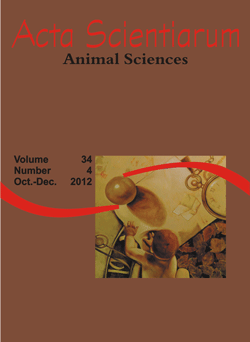<b>Nutritional value of Marandu grass, under grazing by three sampling methods</b> - doi: 10.4025/actascianimsci.v34i4.13745
Resumo
To evaluate the grass B. brizantha cv. Marandu, under grazing, we use three sampling methods: total availability (TA), hand plucked (HP) and extrusa (EXT) in a completely randomized design with four replications. The hand plucked method was collected manually after observing the behavior of grazing animals. TA was determined by cutting at ground level, using a metallic square (0.25 m²) and EXT was collected by rumen evacuation. The values for dry matter (DM), neutral detergent fiber (NDF) and acid detergent fiber (ADF), were 27.20, 88.52 and 43.70% in the treatment and HP, and 25.53, 87.70 and 45.50% in TA. The extrusa had the lowest DM content (15.88%) and higher crude protein (CP) (15.22%), possibly due to the presence of saliva. The levels checked for extrusa NDF, ADF and in vitro digestibility of dry matter were 81.98, 36.90 and 79.10%, demonstrating the selectivity of the animals. The high levels of FDA for TA reflect the composition of the forage with the high proportion of senescent material. The samples obtained by the total availability were not representative of the diet consumed by cattle. The different sampling methods influence the chemical composition of B. Brizantha cv. Marandu.
Downloads
DECLARAÇÃO DE ORIGINALIDADE E DIREITOS AUTORAIS
Declaro que o presente artigo é original, não tendo sido submetido à publicação em qualquer outro periódico nacional ou internacional, quer seja em parte ou em sua totalidade.
Os direitos autorais pertencem exclusivamente aos autores. Os direitos de licenciamento utilizados pelo periódico é a licença Creative Commons Attribution 4.0 (CC BY 4.0): são permitidos o compartilhamento (cópia e distribuição do material em qualqer meio ou formato) e adaptação (remix, transformação e criação de material a partir do conteúdo assim licenciado para quaisquer fins, inclusive comerciais.
Recomenda-se a leitura desse link para maiores informações sobre o tema: fornecimento de créditos e referências de forma correta, entre outros detalhes cruciais para uso adequado do material licenciado.








































